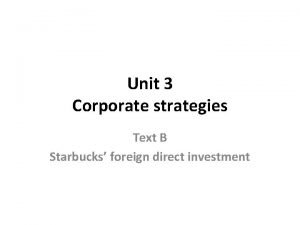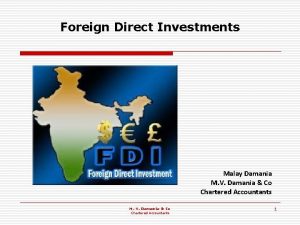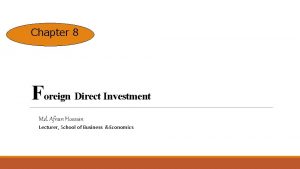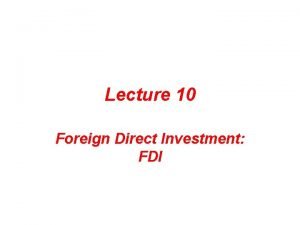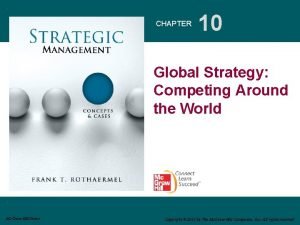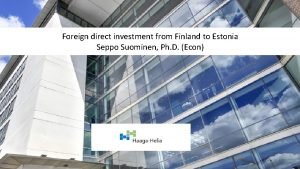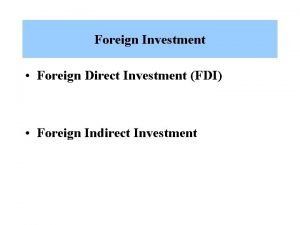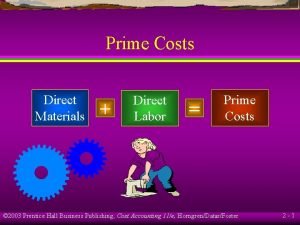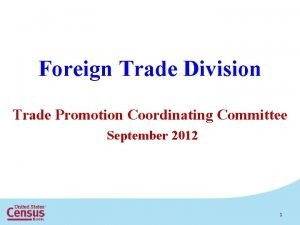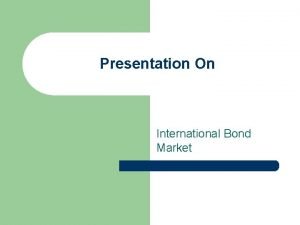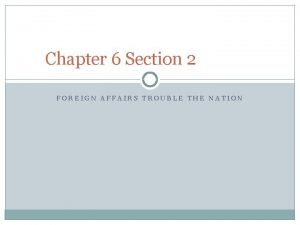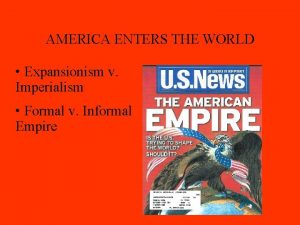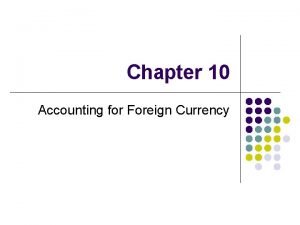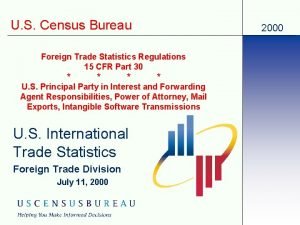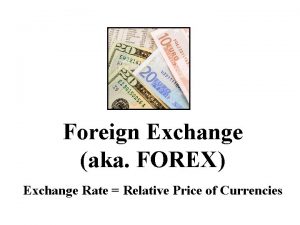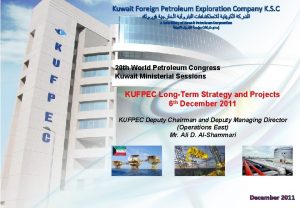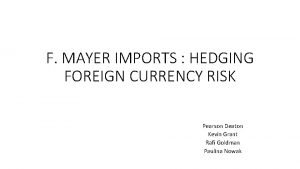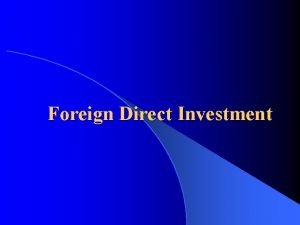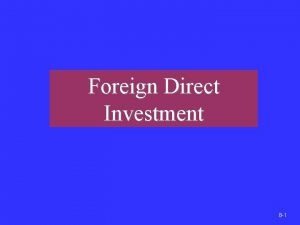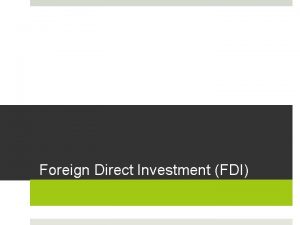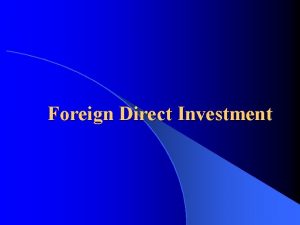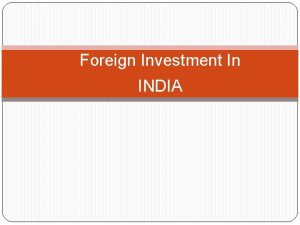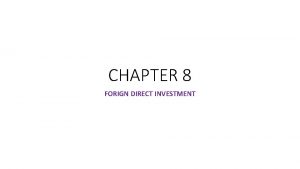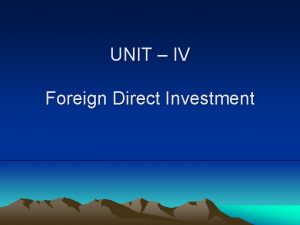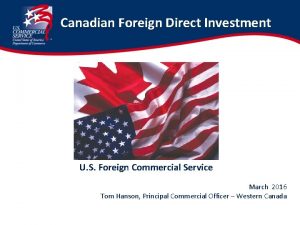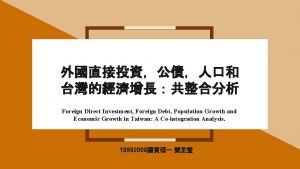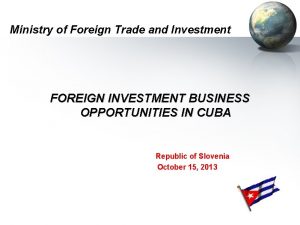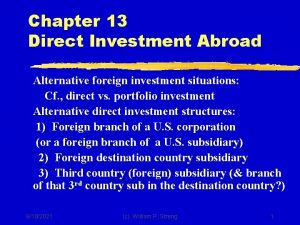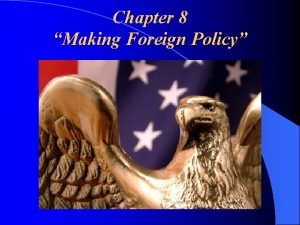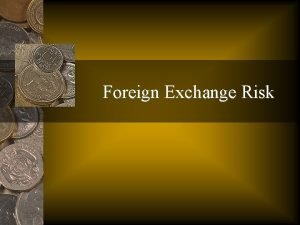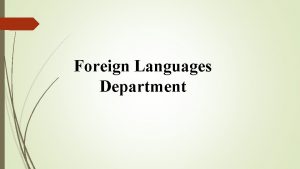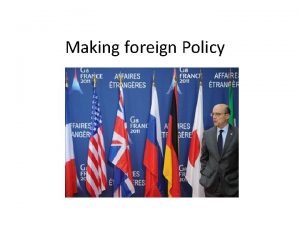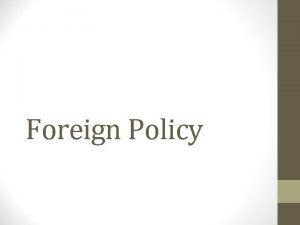Foreign Direct Investment What is foreign direct investment




























- Slides: 28

Foreign Direct Investment

What is foreign direct investment? According to the United Nations Conference on Trade and Development, foreign direct investment is an investment involving management control of a resident entity in one economy by an enterprise resident in another country.

Foreign Direct Investment The establishment or purchase by residents of one country of a substantial ownership and management share-usually measured by a minimum equity stake of 10 percent- of a business in another country.

Foreign Direct Investment The foreign investor can be either by an individual or a corporation, and investment can be wholly owned by foreigners or a joint venture between foreign and local interests.

Foreign Direct Investment through MNCs FDI by MNCs is a major force driving globalization of the world economy. According to a UN Report, there about 60, 000 MNCs in the world with over 500, 000 affiliates. MNCs are growing at a rate of about 10% and MNCs’ world wide sales surpassed by a few trillions compared to world exports.

Multinational Corporations or MNCs A MNC is a business firm incorporated in one country that has production and sales operations in several other countries. The term suggests a firm obtaining raw materials from one national market and financial capital from another, producing goods with labor and capital equipment in a third country, and selling the finished product in yet other national market.

Two forms of FDI • Horizontal Direct Investment – FDI in the same industry abroad as company operates at home. – Vertical direct investment – Backward - investments into industry that provides inputs into a firm’s domestic production (typically extractive industries) – Forward - investment in an industry that utilizes the outputs from a firm’s domestic production (typically sales and distribution)

FDI when and why? • • • Transportation costs are high Market Imperfections (Internalization Theory) – Impediments to the free flow of products between nations – Impediments to the sale of know-how Follow the lead of a competitor - strategic rivalry Product Life Cycle - however, does not explain when it is profitable to invest abroad Location specific advantages (natural resources)

VDI, when and why? • Market power – create entry barriers – erode entry barriers • Market imperfections – Impediments to the sale of know-how – Investments in specialized assets

Decision framework How high are transportation costs and tariffs? High Is know-how amenable to licensing? Yes Low No Yes Is tight control over foreign operation required? No Can know-how be protected by licensing contract? Yes Then license No Export Horizontal FDI

Impediments to the sale of know-how Risk giving away know-how to competitors Impediments to the sale of know how Licensing implies low control over foreign entity Know-how not amenable to licensing

Aims of FDI by the Investors • Technological assets seeking • Efficiency-seeking for third markets • Market-seeking (national or regional) • Natural resource seeking • Corporate strategy

What do we mean by success in foreign direct investment? • Skill development/technology transfer to the nationals • Reduction in wastage of natural resources • Employment into key positions in the industries funded by FDI • Linkages and spill over into higher value added industries

Why is FDI important ? • Firms want a presence in foreign markets • Firms want control over growth of these foreign markets – – – To gain first mover advantages To ward off competitors To determine locations, advertising and other related strategic decisions in the firm’s interest

FDI’s Benefits varies FDI’s benefits are not automatic and are primarily reflected in variables having to do with productive development such as: • Technology transfer and assimilation (TTA) • Training of human resources (HR) • Production linkages (PL) • Local enterprise development (ED), etc. Impacts may be positive or negative and vary depending on the type of corporate strategy

Possible determinants of FDI • Natural resource • Economic factors • Political factors, • Policies: the policy framework foreign direct • investment into the countries Social factor

How is foreign direct investment made • Company acquiring or merging with a firm • • • in a different country A firm creating a ‘Greenfield’ operation in a different country A firm creating a subsidiary in a different country As a result – The firm has significant control of its foreign operation – Firm can affect managerial decisions of the foreign operation

FDI - Flow versus stock • FDI occurs when a firm invests directly in facilities to produce and/or market a product in a foreign country – Flow: Amount of FDI over a period of time (one year) – Stock: Total accumulated value of foreign owned assets at a given point in time • FDI is not the investment by individuals, firms or public bodies in foreign financial instruments

Trends in FDI • Flow and stock increased in the last 20 years • In spite of decline of trade barriers, FDI has grown more rapidly than world trade because – Businesses fear protectionist pressures – FDI is seen a a way of circumventing trade barriers – Dramatic political and economic changes in many parts of the world – Globalization of the world economy has raised the vision of firms who now see the entire world as their market

Form Of FDI: Greenfield versus acquisitions • Green field • Mergers and operation: – Mostly in developing nations acquisitions: – Quicker to execute. – Foreign firms have valuable strategic assets – Believe they can increase the efficiency of the acquired firm • More prevalent in developed nations

Why should a country market itself? • To increase the quantity of foreign investment directly; • To increase the quantity of foreign investment indirectly by • • improving the country’s investment image; To increase the quality of foreign investment directly or indirectly by targeting specific types of investors; To increase the number of firms competing to invest in a specific project;

Variables that are crucial for marketing a country • The product or the intrinsic advantages and • • disadvantages of the investment site; The price or the cost to the investor of locating and operating within the investment site. This usually means tax incentive, grants, tariff protection, and similar price mechanisms; Promotion, or activities that disseminate information about, or attempt to create an image of the investment site and provide investment services for the prospective investor.

Promotional techniques for attracting FDI • • • Advertising in general financial media; Participating in investment exhibition; Advertising in industry- or sector specific media; Conducting general investment missions from source country to host country or from host country to source country; Conducting general information seminars on investment opportunities; Engaging in direct mail or telemarketing campaigns

Promotional techniques for attracting FDI • Conducting industry- or sector specific investment missions • • from source country to host country or vice versa; Conducting industry or sector specific information seminars; Engaging in firm specific research followed by “sales” presentations; Expediting the processing of applications and permits; Providing post investment services.

Efficiency-seeking strategy for winning over new markets • Increased exports of manufactures • Increased international competitiveness of • • • manufactures Technology transfer and assimilation Training of human resources Creation and deepening of production linkages Local enterprise development Shift from an assembly platform towards a manufacturing centre

Potential benefits Efficiency-seeking strategy for winning over new markets • Concentration on static comparative advantages rather than • • • dynamic ones Few production linkages: reliance on imported components in assembly operations. Worst-case scenario: stagnation in the low value-added trap. Crowding out of local firms Lowering of standards in production costs (wages, social benefits and exchange rate) Unsustainable incentives (taxes and infrastructure) Limited industrial and technological upgrading and limited creation of clusters

Drawbacks of FDI: Technical Reasons • The production-sharing mechanism minimizes local benefits owing to the obligation to use (more expensive) inputs from that country. • Lowering of standards in production costs (wages, social benefits via competitive devaluations) in combination with increased incentives. • EPZ mentality • WTO phases out the Multi-Fibre Arrangement (which benefits the • Asian countries, especially China). The effects of regional FTA are unclear (especially with respect to regional rules of origin).

What policies should be pursued? • Technology policies • Incentives: macroeconomic policies, free trade and • • domestic competition Skills: indigenous capacity building Information and technical support (links with research institutes, R&D institutions) Finance for the industrial technology development Conscious policies that will regenerate the environment and the society, and equipping the various agencies responsible for the environment
 Starbucks foreign direct investment
Starbucks foreign direct investment Foreign direct investment in malay
Foreign direct investment in malay Foreign direct investment advantages and disadvantages
Foreign direct investment advantages and disadvantages Afnan hossain
Afnan hossain Pros and cons of greenfield investment
Pros and cons of greenfield investment Foreign direct investment advantages and disadvantages
Foreign direct investment advantages and disadvantages Too foreign for home
Too foreign for home Foreign investment in finland
Foreign investment in finland Foreign indirect investment
Foreign indirect investment Fixed investment and inventory investment
Fixed investment and inventory investment No direct foreign marketing
No direct foreign marketing No direct foreign marketing adalah
No direct foreign marketing adalah Direct investment and collaborative strategies
Direct investment and collaborative strategies Homestrings
Homestrings Direct material + direct labour
Direct material + direct labour A fast progressing foreign company
A fast progressing foreign company Foreign trade regulations ftr
Foreign trade regulations ftr Types of international trade
Types of international trade How jdbc works
How jdbc works Eurobond market size
Eurobond market size Foreign affairs chapter 6
Foreign affairs chapter 6 Foreign policy imperialism
Foreign policy imperialism Foreign currency accounting
Foreign currency accounting Manchuria apush
Manchuria apush Foreign school audit guide
Foreign school audit guide Foreign trade statistics regulations
Foreign trade statistics regulations Foreign exchange shifters
Foreign exchange shifters Kuwait foreign petroleum exploration company k.s.c.
Kuwait foreign petroleum exploration company k.s.c. F mayer imports case study solution
F mayer imports case study solution
